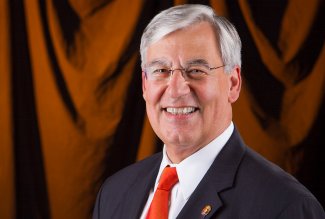
Administrative Staff Council speaker series featured four decades of higher-ed insight from President Dan DiBiasio
Ohio Northern University's Administrative Staff Council continued its series of professional development lectures with an informative talk from ONU President Dan DiBiasio on Thursday, April 21, in the activities room of the James Lehr Kennedy Engineering Building. The series is aimed at providing staff with opportunities to expand their knowledge and skills in topics related to working with others.
DiBiasio is currently the longest tenured Ohio private college or university president and is set to retire at the end of June 2022. He spoke to an attentive audience about the five biggest changes he has witnessed over his 46-year career in higher education, and proposed future trends to watch for in the years to come, before answering audience questions.
“My assignment for today has been kind of a daunting task in some respects, which has caused me to feel my age a little bit more, but also feel my good fortune to work in a purpose-driven enterprise for so, so long with such incredible colleagues,” he said.
DiBiasio began his talk with a “proverbial trip down memory lane,” chronicling his career from its start in 1974 at Rocky Mountain College in Billings, Montana, to his first major administrative job as assistant dean of the graduate school at The Ohio State University, to leading a consortium of the six land-grant colleges in New England where he worked closely with those institutions’ presidents before becoming one himself at Wilmington College and finally at ONU. As he laid out his “five big changes” he’s witnessed over his career, he drew examples from his personal experiences along the way.
According to DiBiasio, the greatest change to higher education over the past 45 years, without question, has been the advancement of technology. Colleges and universities have gone from “no tech, to tech everywhere” in mere decades, profoundly impacting higher education to its core.
“The first real change for higher education in over 1,000 years came as a result of the internet boom,” said DiBiasio. “For the first time, content could be instantly distributed to mass audiences in disparate geographic locations, and students could freely find the content they sought. The internet effectively removed each institution’s monopoly over information.”
With that monopoly gone, colleges and universities lost a bit of their luster within their communities, ushering in what DiBiasio referred to as a change “from the Ivory Tower to the connected campus.” Colleges and universities began to face pushback from their communities over things like their use of public services while being tax-exempt, and so more concerted efforts to form mutually beneficial partnerships became the norm. DiBiasio spoke about his time at the University of New Hampshire, and the consternation there between the town and the university over student conduct of those who lived off-campus, which led to a change to the university’s mission statement to emphasize community service.
A positive example of a college rising to help its community came while DiBiasio was president of Wilmington College in 2008. The area’s largest employer, international shipping firm DHL closed its facility and laid off 7,000 workers. The college leaned on its agriculture program and its service ethos as a Quaker institution and started a community gardens program called Grow Food, Grow Hope, which helped feed those in need. First Lady Chris Burns-DiBiasio, who was one of the leaders of that initiative, brought many of those lessons to ONU, establishing Ada Civic Engagement Day and the Affinity Gardens projects as a result.
Rounding out his “five big changes” was an overall trend in expansion in areas of curriculum, administration and campus dining; the climbing costs and increasing unaffordability of college; and demographic shifts of the student body. Whereas the first two changes DiBiasio identified have largely set in and are permanent realities of higher education, the last three are still very fluid and present ongoing challenges for administrators today.
“The cost of college has ballooned in the past 40 years compared to inflation, but even as college has gotten more costly, it is also costly not to go, as college graduates tend to earn twice as much as those without a bachelor’s degree,” said DiBiasio. “So it’s important to keep both things in mind.”
As for the future, while DiBiasio enjoys his well-earned retirement, he’ll be watching to see if his predictions for future trends come true. Particularly he thinks we’ll see more colleges begin to operate year-round as opposed to the 2/3rds of the year that has been the normal for centuries. The change would be predicated on giving students more access to coursework in a shorter amount of time, the idea being the less time to degree the less cost. He also predicts a rise in three-year degree programs for the same reason.
The pandemic forced many colleges and universities to alter their academic offerings and delivery methods. There is little reason to expect any less virtual integration into curricula in the future. The pandemic also exacerbated the economic strain of higher education and so institutions will have to look long and hard and cost reduction measures and additional revenue streams.
“President DiBiasio's presentation was a perfect culmination to the Administrative Staff Council's professional development series this year, focused on topics of communication and leadership,” says Melanie Weaver, ASC co-chair of professional development. “Our campus community has benefited from President Dan's leadership for 11 years and we appreciated the opportunity to benefit once more from President Dan's reflections on his long tenure in higher education leadership and thoughts about the future landscape.”